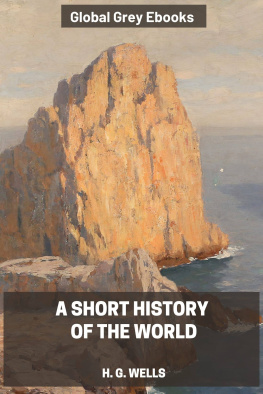H. G. Wells - A Short History of the World
Here you can read online H. G. Wells - A Short History of the World full text of the book (entire story) in english for free. Download pdf and epub, get meaning, cover and reviews about this ebook. year: 2021, publisher: Global Grey, genre: Religion. Description of the work, (preface) as well as reviews are available. Best literature library LitArk.com created for fans of good reading and offers a wide selection of genres:
Romance novel
Science fiction
Adventure
Detective
Science
History
Home and family
Prose
Art
Politics
Computer
Non-fiction
Religion
Business
Children
Humor
Choose a favorite category and find really read worthwhile books. Enjoy immersion in the world of imagination, feel the emotions of the characters or learn something new for yourself, make an fascinating discovery.
A Short History of the World: summary, description and annotation
We offer to read an annotation, description, summary or preface (depends on what the author of the book "A Short History of the World" wrote himself). If you haven't found the necessary information about the book — write in the comments, we will try to find it.
A Short History of the World — read online for free the complete book (whole text) full work
Below is the text of the book, divided by pages. System saving the place of the last page read, allows you to conveniently read the book "A Short History of the World" online for free, without having to search again every time where you left off. Put a bookmark, and you can go to the page where you finished reading at any time.
Font size:
Interval:
Bookmark:

A Short History of the World
by H. G. Wells
First published in 1922
This ebook edition was created and published by Global Grey
The artwork for the cover is Seascape
painted by Willy Hamacher.
You can download this book on the site:
globalgreyebooks.com/short-history-of-the-world-ebook.html

GlobalGrey 2021
globalgreyebooks.com
The story of our world is a story that is still very imperfectly known. A couple of hundred years ago men possessed the history of little more than the last three thousand years. What happened before that time was a matter of legend and speculation. Over a large part of the civilized world it was believed and taught that the world had been created suddenly in 4004 B.C., though authorities differed as to whether this had occurred in the spring or autumn of that year. This fantastically precise misconception was based upon a too literal interpretation of the Hebrew Bible, and upon rather arbitrary theological assumptions connected therewith. Such ideas have long since been abandoned by religious teachers, and it is universally recognized that the universe in which we live has to all appearances existed for an enormous period of time and possibly for endless time. Of course there may be deception in these appearances, as a room may be made to seem endless by putting mirrors facing each other at either end. But that the universe in which we live has existed only for six or seven thousand years may be regarded as an altogether exploded idea.
The earth, as everybody knows nowadays, is a spheroid, a sphere slightly compressed, orange fashion, with a diameter of nearly 8,000 miles. Its spherical shape has been known at least to a limited number of intelligent people for nearly 2,500 years, but before that time it was supposed to be flat, and various ideas which now seem fantastic were entertained about its relations to the sky and the stars and planets. We know now that it rotates upon its axis (which is about 24 miles shorter than its equatorial diameter) every twenty-four hours, and that this is the cause of the alternations of day and night, that it circles about the sun in a slightly distorted and slowly variable oval path in a year. Its distance from the sun varies between ninety-one and a half millions at its nearest and ninety-four and a half million miles.
About the earth circles a smaller sphere, the moon, at an average distance of 239,000 miles. Earth and moon are not the only bodies to travel round the sun. There are also the planets, Mercury and Venus, at distances of thirty-six and sixty-seven millions of miles; and beyond the circle of the earth and disregarding a belt of numerous smaller bodies, the planetoids, there are Mars, Jupiter, Saturn, Uranus and Neptune at mean distances of 141, 483, 886, 1,782, and 1,793 millions of miles respectively. These figures in millions of miles are very difficult for the mind to grasp. It may help the readers imagination if we reduce the sun and planets to a smaller, more conceivable scale.
If, then, we represent our earth as a little ball of one inch diameter, the sun would be a big globe nine feet across and 323 yards away, that is about a fifth of a mile, four or five minutes walking. The moon would be a small pea two feet and a half from the world. Between earth and sun there would be the two inner planets, Mercury and Venus, at distances of one hundred and twenty-five and two hundred and fifty yards from the sun. All round and about these bodies there would be emptiness until you came to Mars, a hundred and seventy-five feet beyond the earth; Jupiter nearly a mile away, a foot in diameter; Saturn, a little smaller, two miles off; Uranus four miles off and Neptune six miles off. Then nothingness and nothingness except for small particles and drifting scraps of attenuated vapour for thousands of miles. The nearest star to earth on this scale would be 40,000 miles away.
These figures will serve perhaps to give one some conception of the immense emptiness of space in which the drama of life goes on.
For in all this enormous vacancy of space we know certainly of life only upon the surface of our earth. It does not penetrate much more than three miles down into the 4,000 miles that separate us from the centre of our globe, and it does not reach more than five miles above its surface. Apparently all the limitlessness of space is otherwise empty and dead.
The deepest ocean dredgings go down to five miles. The highest recorded flight of an aeroplane is little more than four miles. Men have reached to seven miles up in balloons, but at a cost of great suffering. No bird can fly so high as five miles, and small birds and insects which have been carried up by aeroplanes drop off insensible far below that level.
In the last fifty years there has been much very fine and interesting speculation on the part of scientific men upon the age and origin of our earth. Here we cannot pretend to give even a summary of such speculations because they involve the most subtle mathematical and physical considerations. The truth is that the physical and astronomical sciences are still too undeveloped as yet to make anything of the sort more than an illustrative guesswork. The general tendency has been to make the estimated age of our globe longer and longer. It now seems probable that the earth has had an independent existence as a spinning planet flying round and round the sun for a longer period than 2,000,000,000 years. It may have been much longer than that. This is a length of time that absolutely overpowers the imagination.
Before that vast period of separate existence, the sun and earth and the other planets that circulate round the sun may have been a great swirl of diffused matter in space. The telescope reveals to us in various parts of the heavens luminous spiral clouds of matter, the spiral nebul, which appear to be in rotation about a centre. It is supposed by many astronomers that the sun and its planets were once such a spiral, and that their matter has undergone concentration into its present form. Through majestic ons that concentration went on until in that vast remoteness of the past for which we have given figures, the world and its moon were distinguishable. They were spinning then much faster than they are spinning now; they were at a lesser distance from the sun; they travelled round it very much faster, and they were probably incandescent or molten at the surface. The sun itself was a much greater blaze in the heavens.
If we could go back through that infinitude of time and see the earth in this earlier stage of its history, we should behold a scene more like the interior of a blast furnace or the surface of a lava flow before it cools and cakes over than any other contemporary scene. No water would be visible because all the water there was would still be superheated steam in a stormy atmosphere of sulphurous and metallic vapours. Beneath this would swirl and boil an ocean of molten rock substance. Across a sky of fiery clouds the glare of the hurrying sun and moon would sweep swiftly like hot breaths of flame.
Slowly by degrees as one million of years followed another, this fiery scene would lose its eruptive incandescence. The vapours in the sky would rain down and become less dense overhead; great slaggy cakes of solidifying rock would appear upon the surface of the molten sea, and sink under it, to be replaced by other floating masses. The sun and moon growing now each more distant and each smaller, would rush with diminishing swiftness across the heavens. The moon now, because of its smaller size, would be already cooled far below incandescence, and would be alternately obstructing and reflecting the sunlight in a series of eclipses and full moons.
Next pageFont size:
Interval:
Bookmark:
Similar books «A Short History of the World»
Look at similar books to A Short History of the World. We have selected literature similar in name and meaning in the hope of providing readers with more options to find new, interesting, not yet read works.
Discussion, reviews of the book A Short History of the World and just readers' own opinions. Leave your comments, write what you think about the work, its meaning or the main characters. Specify what exactly you liked and what you didn't like, and why you think so.















